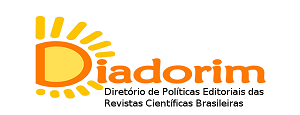INDICADORES-GUIAS PARA AVALIAÇÃO DA SUSCEPTIBILIDADE À DESERTIFICAÇÃO NOS SISTEMAS AMBIENTAIS DA SUB-BACIA DO RIACHO JURITI, CANINDÉ, CEARÁ
DOI:
https://doi.org/10.70860/rtg.v14i32.19390Palavras-chave:
Desertificação, Semiárido, IndicadoresResumo
Para compreender a sensibilidade dos ambientes à desertificação é necessário entender sua estrutura, dinâmica e resposta às interferências externas. Diante disso, o sistema de Indicadores Geobiofísicos de Desertificação (IGBD) é adaptado à pesquisa para analisar a susceptibilidade dos sistemas à desertificação na sub-bacia do riacho Juriti, no município de Canindé, Ceará. O geoprocessamento foi realizado no QGIS, onde o modelo de susceptibilidade foi construído por meio da sobreposição ponderada dos atributos dos indicadores. Averiguou-se que a susceptibilidade dos sistemas varia de baixa a alta conforme as características do ambiente, embora o uso e cobertura, assim como a indicação do estado de conservação da vegetação, mediante Índice de Vegetação Ajustado ao Solo (SAVI), determinem os valores do índice nos diferentes sistemas ambientais, mostrando-se como guias para esse tipo de análise. Observa-se, pois, que a vegetação conservada e determinados usos e coberturas que promovem a estabilidade podem elevar o grau de proteção, levando à diminuição da sensibilidade dos ambientes à desertificação.
Referências
ABRAHAM, Elena María; BEEKMAN, Gertjan B. Indicadores de la deserfificación para América del Sul. Mendoza, Argentina: LaDyOT - IADIZA - CONICEF, 2006.
ANDRANDE, C. B.; OLIVEIRA, L. M. M.; OMENA, J. A. M.; GUSMÃO, A. C. V. L.; RODRIGUES, D. F. B. Avaliação de índices de vegetação e características fisiográficas no Sertão de Pernambuco. Revista Brasileira de Meio Ambiente, v. 4, n. 1, p. 97-107, 2018.
ARAÚJO, D. T. Indicadores de degradação ambiental/desertificação no município de Parambu/CE. Dissertação (Mestrado em Desenvolvimento e Meio Ambiente) – Programa de Pós-Graduação em Desenvolvimento e Meio Ambiente - PRODEMA, Universidade Federal do Ceará, Fortaleza, 2015.
AYOADE, J. O. Introdução à climatologia para os trópicos. Rio de Janeiro: Bertrand Brasil, 1996.
BERRETO, L. L. Indicadores geobiofísicos de susceptibilidade à desertificação nas serrar de Uruburetama, da Meruoca e nos Sertões do Centro Norte – Ceará – Brasil. Tese (Doutorado em Geografia) - Programa de Pós-Graduação em Geografia, Universidade Federal do Ceará, Fortaleza, 2018.
BRASIL. Ministério do Meio Ambiente (MMA). Programa de Ação Nacional de Combate à Deserti#cação e Mitigação dos Efeitos da Seca. PAN-BRASIL. Edições MMA. Brasília, 2004.
CHERLET, M., HUTCHINSON, C., REYNOLDS, J., HILL, J., SOMMER, S., VON MALTITZ, G. World Atlas of Desertification. Luxembourg: Publication Office of the European Union, Luxembourg, 2018.
COSTA, L. R. F.; OLIVEIRA, V. P. V. Sistemas ambientais e indicadores de desertificação: dinâmica das paisagens semiáridas na sub-bacia hidrográfica do riacho Santa Rosa. Ateliê Geográfico, Goiânia, v. 11, n. 2. P. 238-258, 2017. DOI: https://doi.org/10.5216/ag.v11i2.39633
COSTA. L. R. F. Estruturação geoambiental e susceptibilidade à desertificação na Sub-bacia Hidrográfica do riacho Santa Rosa – Ceará. Dissertação (Mestrado em Geografia) – Programa de Pós-Graduação em Geografia, Universidade Federal do Ceará, Fortaleza, 2014.
DEMARCHI, J.C.; PIROLI, E.L.; ZIMBACK, C.R.L. Análise temporal do uso do solo e comparação entre os índices de vegetação NDVI e SAVI no município de Santa Cruz do Rio Pardo–SP usando imagens LANDSAT5. Raega-O Espaço Geográfico em Análise, v. 21, 2011. DOI: https://doi.org/10.5380/raega.v21i0.17416
FUNDAÇÃO CEARENSE DE METEOROLOGIA E RECURSOS HÍDRICOS - FUNCEME. Portal Hidrológico do Ceará. Fortaleza: 2023. Disponível em: http://www.funceme.br/hidro-ce-zend/app/pagina/show/159. Acesso em: 10 dez. 2023.
INSTITUTO BRASILEIRO DE GEOGRAFIA E ESTATÍSTICA. Nota Técnica N°41. Índice de vulnerabilidade à desertificação e sua correlação com o desenvolvimento dos municípios cearenses.Fortaleza: IPECE, 2009.
INSTITUTO DE PESQUISA E ESTRATÉGIA ECONÔMICA DO CEARÁ. Mapa des Unidades Fitoecológicas do Ceará. Fortaleza: IPECE, 2021. Disponível em: http://www2.ipece.ce.gov.br/atlas/capitulo1/12/125x.htm. Acesso em: 17 abri. 2023.
JENSEN, J.R.; EPIPHANIO, J.C.N. Sensoriamento remoto do ambiente: uma perspectiva em recursos terrestres. Parêntese, 2011.
MARTINS, T. I. S.; RODRIGUES, S. C. Análise e mapeamento dos graus de fragilidade ambiental da bacia do médio-baixo curso do rio Araguari, Minas Gerais. Caderno de Geografia, v. 22, n. 38, 2012. DOI: https://doi.org/10.4025/bolgeogr.v30i1.14826
MIRZABAEV, A.; STRINGER, L. C.; BENJAMINSEN, T. A.; GONZALEZ, P.; HARRIS, R.; JAFARI, M.; STEVENS, N.; TIRADO, C. M.; ZAKIELDEEN, S. CrossChapter Paper 3: Deserts, Semiarid Areas and Desertification. In: PÖRTNER, H.O.; ROBERTS, D. C.; TIGNOR, M.; POLOCZANSKA, E. S.; MINTENBECK, K.; ALEGRÍA, A.; CRAIG, M.; LANGSDORF, S.; LÖSCHKE, S.; MÖLLER, V.; OKEM, A.; RAMA, B. (org.) Climate Change 2022: Impacts, Adaptation and Vulnerability. Contribution of Working Group II to the Sixth Assessment Report of the Intergovernmental Panel on Climate Change. UK: Cambridge University Press, 2022. p. 2195–2231. DOI: https://doi.org/10.1017/9781009325844.020
MORO. M. F.; MACEDO, M. B.; MOURA-FÉ, M. M.; CASTRO, A. S. F.; COSTA, R. C. Vegetação, unidades fitoecológicas e diversidade paisagística do estado do Ceará. Rodriguésia, p. 717-743, 2015. DOI: https://doi.org/10.1590/2175-7860201566305
OLIVEIRA, V. P. V. Indicadores Biofísicos de Desertificação, Cabo Verde/África. Mercator – Revista de Geografia da UFC, v. 10, n. 22, p. 147 – 168, mai./ago. 2011. DOI: https://doi.org/10.4215/RM2011.1022.0010
ROSS, J. L. S. O registro cartográfico dos fatos geomorfológicos e a questão da taxonomia do relevo. Revista do Departamento de Geografia, n.6, São Paulo: Edusp, p. 17-30. 1992. DOI: https://doi.org/10.7154/RDG.1992.0006.0002
_____. Análise empírica da fragilidade dos ambientes naturais e antropizados. Revista do Departamento de Geografia, n.8, São Paulo: Edusp, p. 63-74. 1994. DOI: https://doi.org/10.7154/RDG.1994.0008.0006
ROUSE, J.W.; HAAS, R.H.; SCHELL, J.A.; DEERING, D.W. Monitoring vegetation systems in the Great Plains with ERTS. In: Earth RESOURCES TECHNOLOGY SATELLITE-1 SYMPOSIUM, 3., 1973, Washington. Proceedings. Washington: NASA, 1974. v.1, p.309-317.
SILVA, E. G. B. Degradação das terras secas nos sertões de Santa Quitéria e Independência – Ceará: contribuições ao monitoramento ambiental. Tese (Doutorado em Geografia) – Programa de Pós-Graduação em Geografia, Universidade Federal do Ceará, Fortaleza, 2018.
SILVA, L. G.; GALVÍNCIO, J. D. Análise comparativa da variação nos índices NDVI e SAVI no sítio PELD – 22, em Petrolina – PE, na primeira década do século XXI. Revista Brasileira de Geografia Física, Pernambuco, p. 1446-1456, 2012. DOI: https://doi.org/10.5935/1984-2295.20120085
SOUZA, A. C. N.; SOUZA, S. D. G.; SOUSA, M. L. M. Sistema de indicadores de desertificação no semiárido brasileiro: uma revisão sistemática integrativa da literatura. Geografares [Online], 36 | 2023. DOI: https://doi.org/10.4025/bolgeogr.v41.a2023.e64785
SOUZA, M. N. Bases naturais e esboço do zoneamento geoambiental do estado do Ceará. In: LIMA, L. C.; ORAIS, J. O.; SOUZA, M. J. N. Compartimentação territorial e gestão regional do Ceará. Parte I. Fortaleza: FUNECE, 2000.
SPORL, C.; ROSS, J. L. S. Análise comparativa da fragilidade ambiental com aplicação de três modelos. GEOUSP, Espaço e Tempo, São Paulo, n. 15, p. 39-49, 2004.
TRICART, J. Ecodinâmica. Rio de Janeiro: IBGE, 1977. 97 p.
TRICART, J. A geomorfologia, a edafologia e o ordenamento do espaço rural. GEOgrafia, v. 5, n. 9, 2003. DOI: https://doi.org/10.22409/GEOgraphia2003.59.a13448
Downloads
Publicado
Como Citar
Edição
Seção
Licença
Copyright (c) 2025 Revista Tocantinense de Geografia

Este trabalho está licenciado sob uma licença Creative Commons Attribution-NonCommercial-NoDerivatives 4.0 International License.
A Revista Tocantinense de Geografia não remunera nenhum autor pela publicação de seus textos. Os conteúdos dos textos publicados neste periódico são de responsabilidade de seus autores.








.png)












